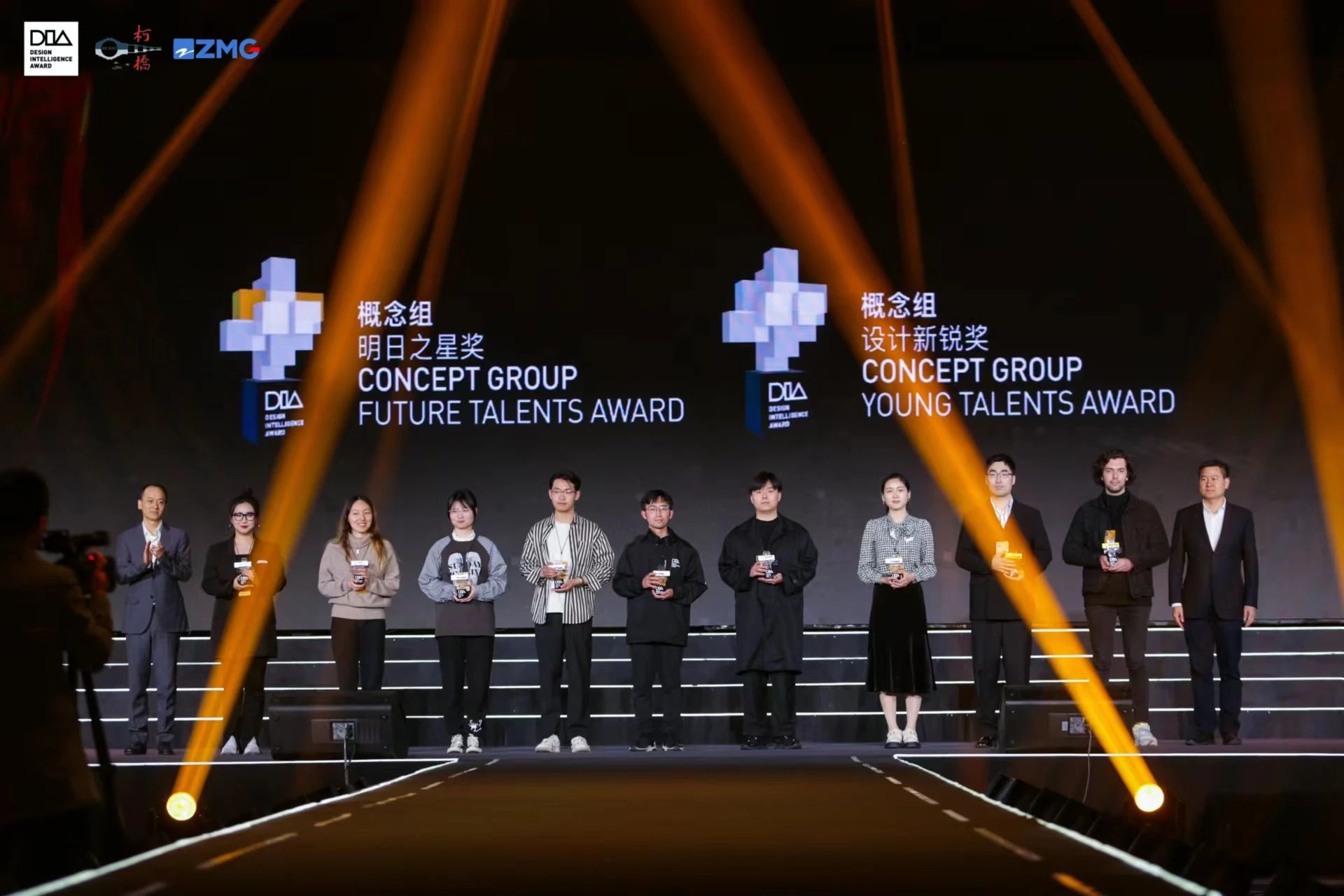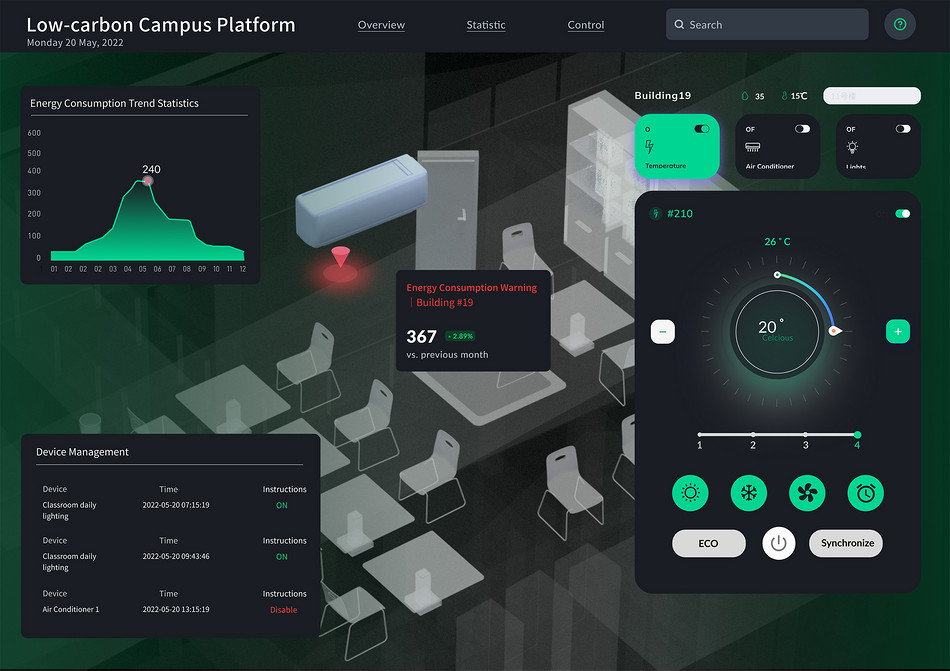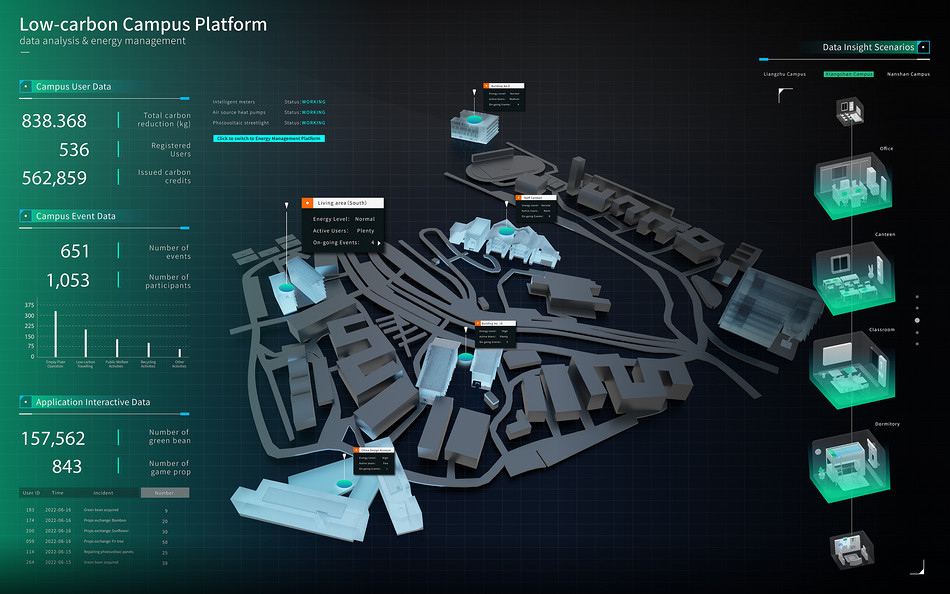
Everyone can do something to help realize the “goal of carbon peaking and carbon neutrality". The campus is one of the main scenarios of carbon emission. During the construction of low-carbon campus, in addition to reducing energy consumption and carbon emission, it is the most effective way to drive teachers and students to actively carry out low-carbon actions. We should encourage them to consciously become practitioners and disseminators of the concept of low carbon, so as to form a campus fashion of everyone participates in low carbon construction and environmental protection.

Low-carbon Campus
2022DIA Future Talent Award in Concept Group
Owner: China Academy of Art (CAA)
Manufacturer: Alibaba Cloud Computing Limited
Design team: Chen Yunjia, Xiao Lei, Feng Ruiyun, Ding Yuxin, Cai Herui

The third from right is the representative of the design team
No. 1 The green sprout and its extension
At first, a group of photos comparing CAA Xiangshan Campus in 2007 and 2021 circulated on the Internet aroused the emotion of members of the school-enterprise workshop (the workshop was jointly created by the CAA Design Innovation Center and Alibaba Cloud Design Center). In 2007, Xiangshan Campus was just completed, and everything was brand-new. After 15 years of precipitation, Xiangshan Campus in 2021 becomes flourishing, buildings and natural landscapes coexist harmoniously in the campus, teachers and students become more, and the campus becomes greener. Team members were naturally moved by the traces of time. In the meantime, members have some thoughts about whether the study and life on campus can become "greener" besides the “green” landscape. Therefore, the concept and design scheme of low-carbon campus came into being.

Comparison between CAA Xiangshan Campus in 2007 and 2021
(Photos are from the Internet)
DIA Committee learned that the project was mainly developed by teachers and students of the CAA Design Innovation Center and Alibaba Cloud Energy Consumption Cloud Team. Teachers and students are responsible for the overall system architecture construction, product design and operation activities, and Alibaba Cloud provides data analysis, carbon peaking and carbon neutrality intelligent algorithm and product development services.
They conducted a questionnaire survey on climate change actions for nearly 10,000 college students, and analyzed the questionnaires with Binary Logistic model, and found that the action path has a significant impact on the respondents’ willingness to act. The conclusion proves that it is feasible to drive students to implement low-carbon behaviors through behavior design, so what the team should do is to provide more opportunities for people in campus to participate in low-carbon actions.
No.2 Novel design driver
Compared with the traditional low-carbon campus construction scheme, the innovation of this project lies in that it constructs a campus low-carbon cultural ecology with the design concept of "college is community, low carbon is fashion"; The project breaks through the inherent barriers of specialty boundary in the construction of low-carbon campus and promote the achievement transformation of interdisciplinary integration in the construction of low-carbon campus, breaks the single mode of pursuing carbon emission reduction, and encourages and quantifies individuals' voluntary emission reduction behavior by digital means by giving full play to the scientific and technological advantages of energy consumption monitoring and analysis and platform operation capabilities.
The project team has created a campus carbon inclusion ecology focusing on low-carbon creation, low-carbon behavior, low-carbon rights and low-carbon public welfare, and constructed a full-link service system. By integrating the existing campus energy consumption data resources, combined with big data, cloud computing and other technologies, we designed and built a manageable, controllable and predictable digital platform tool for campus energy-carbon integration. From the definition of low-carbon campus indicators to the monitoring and analysis of dormitory electricity consumption, they went deep into the nodes of campus life scenarios such as study, residence, production and public service.

In addition, based on the carbon footprint of personal daily life behavior on campus, they launched the “Low-carbon CAA" applet for CAA teachers and students. The platform uses behavioral science methods to guide teachers and students to actively carry out low-carbon actions, actively explores and launches low-carbon micro-actions on campus for students and teachers to obtain carbon credit rewards. The carbon credits can be converted into benefits, thus forming positive incentives for individuals and helping them gradually live a low-carbon lifestyle.
If you are a teacher and student of China Academy of Art, you can get carbon credits through carbon reduction activities such as keeping green plants, low-carbon travel, clean plate campaign and used item recycling, and convert them into benefits such as campus coffee vouchers, canteen meal vouchers, creative low-carbon products and campus cultural and creative products.

The actual application scenarios of these products mainly include three aspects: applet, campus back-end and low-carbon hardware. The applet can provide the functions of personal carbon account, smart electricity bill, low-carbon activities and benefits, and carbon treasure map game, offering low-carbon experience to users by combining online and offline activities. In the campus back-end, energy consumption data, carbon reduction data and low-carbon activity data can be accurately observed and analyzed mainly online through carbon peaking and carbon neutrality intelligent algorithm and data analysis, and campus dynamics can be presented in 3D panorama, through which they can build a low-carbon campus big data cockpit. They also constructed low-carbon energy-saving facilities on campus, such as PV panels, PV street lamps and air source heat pumps. Combined with intelligent management in the back end, they are able to efficiently save energy and reduce emissions.

The team leader recalled: "The most difficult part of product realization is how to design products that meet users’ needs and improve their experience. Taking the function of energy-saving ranking list for example, should we choose the top 50% users or divide them according to the pareto principle. We constantly conduct user research, and understand the users’ needs and put forward strategies based on questionnaires and interviews. What makes them most unforgettable is that during the period when the products were just put into trial operation, unknown problems might appear at any time. They kept a close eye on the operation progress, tried new operation activities, mechanisms and processes, and finally achieved good results in trial operation and obtained a lot of valuable data.

The Low-carbon Campus was launched in Xiangshan Campus of China Academy of Art on April 22, 2022. Compared with the trial operation, the number of active users increased from 10% to 20% of the total number of users after the launch of the applet, reflecting better participation of teachers and students. The applet platform has a total of 1,565 registered users, and 1,829 teachers and students have launched independent low-carbon actions on it, realizing a cumulative emission reduction of 3,305.498kg.
In terms of marketing, the team leader said: "At present, the homogeneity of similar low-carbon campus products in the market is serious, so it is hard for users to distinguish them, and these product are generally face mass users, and users and application scenarios have not been subdivided. However, our products have the advantages of lightweight, low cost and strong reproducibility, which can be laid quickly and centrally, and can be promoted quickly through the community, are not restricted by regional conditions, so you can see the results in a short period with a small investment. At present, the products are being promoted in nearly 100 universities nationwide through the channels of our partners, and the scale is expected to expand in the next three years. ”
No.3 Future product planning
With regard to the main goals in 2023, the team leader introduced that they plan to completion the iteration of the low-carbon campus digital intelligence platform version 2.0 in June 2023, providing a better product for users. Moreover, they will promote the reform of campus low-carbon mechanism system, expand more interesting low-carbon activities, develop more products with low-carbon inclusion benefits, deepen the low-carbon concept into the subdivision scenarios for teachers and students' study and life, and enhance the daily active users of the products. What's more worth mentioning is that from August to October, 2023, some contents of the project will be applied to the Asian Games Village of the 19th Asian Games in Hangzhou, and the social influence of the products will be further expanded.
With the low-carbon campus, a campus carbon inclusion system can be established. From low-carbon game interaction in daily life to ecological link between low-carbon creation, low-carbon benefits and low-carbon public welfare, the low-carbon campus will give full play to the art productivity of design to create low carbon economic value, and help low-carbon campus transformation to become a new fashion of social development.
DIA in the eyes of designers
The members of the low-carbon campus team sincerely expressed their recognition and blessings to DIA: “As the first international academic award in the field of industrial design in China, DIA is an international platform for the evaluation, promotion and cooperation of contemporary innovative design works, a global competition for cross-border innovation in art, technology and business, as well as a physical innovation accelerator from creativity to wealth and future.” They hoped that DIA would have far-reaching international influence in the future, rank among the world-class awards, and carry forward Chinese design and China’s smart manufacturing.
Information provider | Design Team of Low-carbon Campus
Editor | Wu Zhiwen
Executive Editor | Fan Fei
Reviewer | Yang Duoying
Gather Great Wisdom to Shape the Future of Intelligent Manufacturing
Follow us
You will learn more information about the 2013 DIA award-winning works

DIA WeChat official account
Scan the QR code to follow us and learn more about DIA events
